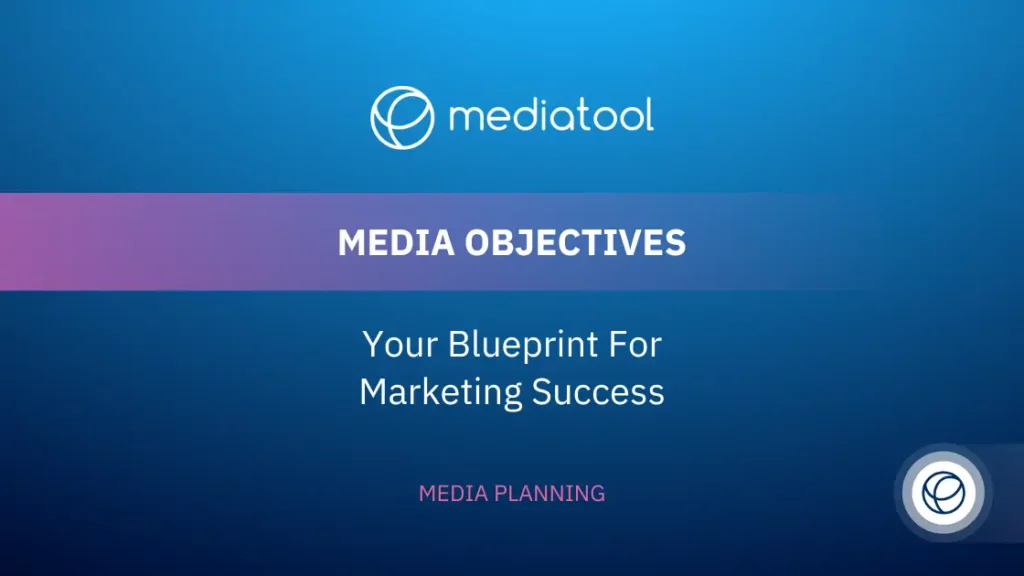Navigating marketing can be challenging. With so many platforms and options, it’s easy to miss the mark without a clear plan. This is where having solid media objectives come into play.
The issue?
A lot of companies spread their efforts too thin without clear goals. This wastes time and money, making it hard to hit those business targets.
As competition heats up, the pressure to stand outgrows. Every missed chance or wrong move can put you behind.
The fix?
Define your media objectives clearly.
These goals are your roadmap through the marketing maze. With them, you can focus your efforts, use your budget wisely, and tweak your strategy to make an impact.
Let’s see how the right media objectives can turn scattered efforts into focused, effective campaigns.
What Are Media Objectives?
Media objectives are the backbone of any successful marketing strategy. They’re the clear goals that guide where, when, and how a company communicates with its target audience.
Think of them as the roadmap for connecting with potential customers across various media channels. By setting these objectives, companies aim to increase brand awareness, boost sales, and build lasting relationships with their audience.
Why Are Media Objectives Important?

The significance of media objectives goes beyond campaign planning; it’s about strategic alignment and optimization of resources for maximum impact. Let’s explore why media objectives are indispensable to any business striving for success in the digital age.
Strategic Focus and Direction
Media objectives provide a clear strategic focus for marketing teams. By setting these objectives, companies ensure that every effort is aligned with their broader business goals.
Whether increasing brand awareness, driving website traffic, or generating leads, media objectives act as a compass, guiding all marketing activities in the right direction. This strategic focus prevents resources from being wasted on activities that don’t contribute to the company’s overall success.
Efficient Resource Allocation
In the realm of advertising, budget efficiency is paramount. Media objectives allow businesses to allocate their marketing budget more effectively. Companies can invest in the right media channels and advertising formats by understanding what they aim to achieve.
This means purchasing ad space on platforms where their target audience is most active, thus ensuring that every dollar spent contributes to achieving the set objectives. It’s a systematic approach to budgeting that maximizes ROI and minimizes wasted expenditure.
Enhanced Measurement and Adjustability
The ability to measure success and make adjustments is a critical advantage of having clear media objectives. These objectives provide tangible metrics that can be monitored and evaluated.
For instance, if the objective is to improve the conversion rate, businesses can track this metric and understand whether their strategies are effective.
This ongoing evaluation enables companies to pivot their media plan quickly, making real-time adjustments to optimize performance. It’s a dynamic process that ensures marketing strategies remain relevant and impactful.
Targeted Communication
One of the core benefits of well-defined media objectives is the ability to effectively tailor communication to the target audience. It’s about ensuring the right message reaches the right people at the right time.
This targeted approach increases the relevance of the communication, enhancing engagement rates and ultimately leading to higher conversion rates.
Media objectives help identify the most suitable platforms and content formats for reaching the intended audience, making communication efforts more strategic and focused.
Competitive Advantage
In a crowded marketplace, standing out is essential. Media objectives give businesses a competitive edge by ensuring their marketing efforts are more strategic, focused, and efficient than their competitors.
Companies that set clear, measurable objectives and align their media strategies accordingly are better positioned to capture the attention of their target audience, build brand loyalty, and drive sales. This strategic advantage is crucial for long-term success and market leadership.
Examples of Media Objectives
Increasing Brand Awareness
Increasing brand awareness is about making your brand visible to many people. Brands must utilize a variety of social media channels to maximize potential reach.
This is where engagement rate and brand awareness metrics become invaluable. They help media planners track how many people see and interact with social media posts.
To achieve this, advertising agencies often recommend a mix of media buying on different channels and creating content that resonates with the target audience. The right message, shared through the right channel, can significantly enhance brand visibility.
Generating Leads
Generating leads is a dynamic process that transforms audience interest into actionable leads. This objective leans heavily on using social media marketing strategies, including targeted email campaigns and purchasing ad space on platforms where potential customers are most active.
Media planners play a key role here, utilizing social media analytics tools to pinpoint which strategies are most effective at reaching the company’s target audience.
By setting clear conversion goals and employing great tools for goal setting, companies can streamline their lead generation efforts, ensuring that every piece of content and ad is designed to generate leads and move potential customers through the sales funnel.
Boosting Sales
The ultimate aim of many marketing campaigns is to boost sales. This objective requires a strategic blend of increasing brand awareness, generating leads, and then meticulously nurturing these leads to drive conversions.
Media buying focused on the right channels, targeted social media posts, and email campaigns can significantly impact sales figures. Key to this process is understanding the conversion rate from leads to sales and continuously optimizing campaigns to improve this metric.
Effective media planners will align media objectives with business goals, ensuring that advertising efforts are not just about visibility but are closely tied to generating tangible sales outcomes.
Building Relationships
At the heart of many social media goals is the objective of building relationships with the audience. This means engaging directly with customers on social platforms, responding to comments, and participating in conversations.
The purpose is to create a sense of community around the brand. This effort requires a consistent and genuine approach to social media posts, emphasizing the importance of the engagement rate as a key metric. By focusing on building relationships, companies can create loyal customers and advocates for their brand.
Media planners and advertising agencies often stress the importance of using insights from social listening to tailor interactions and content, ensuring that the company is always meeting the target audience’s needs.
Each of these objectives requires a tailored media strategy, designed to meet the target audience’s specific needs and align with the overarching business goals. By setting clear objectives, utilizing the right channels, and measuring success with the appropriate metrics, companies can ensure that their media efforts are both effective and efficient.
Finding the Right Media Objectives for Your Marketing Plan

Finding the right media objectives is essential to ensure a successful marketing plan. Here’s how to approach this process.
Define Success
Before diving into the specifics of your campaign, it’s crucial to define what success looks like for you. Is it an increase in website traffic, a boost in the conversion rate, or perhaps a surge in the number of new leads?
Setting this benchmark early on helps in creating focused media objectives that align with what you aim to achieve. For example, if your goal is to lower the bounce rate on your site, your media objective might include creating more engaging content that keeps visitors interested.
Understand Your Audience
A deep understanding of your target customer is the foundation of any successful marketing strategy. Utilize social listening, analyze existing data, and leverage a social media analytics tool to get a comprehensive view of your audience’s preferences and behaviors.
This step ensures that your media objectives are not just guesses but are informed by real insights about what your audience enjoys, needs, and responds to.
Select the Right Media Channels
Not every media channel will be suitable for conveying your message. It’s important to select the platforms where your target audience is most active and engaged. This decision should be based on data and insights gathered during your audience research phase.
A skilled media planner can identify the right channels—whether it’s social media, email, or traditional media—that align with both your marketing objectives and where your audience spends their time.
Set Clear, Time-Bound Objectives
Your objectives should follow the SMART criteria: Specific, Measurable, Achievable, Relevant, and Time-bound. This approach ensures that you can effectively track your progress and make adjustments as necessary.
Setting objectives like “increase website traffic by 20% in the next quarter” provides a clear target for your team and helps keep all efforts focused and aligned.
Use Great Tools
The right tools can make a significant difference in how effectively you can plan, execute, and adjust your media strategy. From social media analytics tools to media planning software, these resources provide valuable insights into your campaign’s performance and help measure key metrics against your objectives.
Media planners often rely on these tools to gather data, analyze trends, and make informed decisions to optimize strategies.
Align with Business Objectives
Ensure that your media objectives directly support your broader business goals. Whether you’re focused on building brand awareness, increasing sales, or breaking into new markets, every aspect of your media plan should contribute towards these overarching targets.
This alignment ensures that your marketing efforts are cohesive and strategically driving your business forward.
Evaluate and Adjust
Media planning is dynamic, requiring regular evaluation and adjustments. Continuously measure your campaign’s performance against the set objectives to understand what’s working and what isn’t.
This might involve tweaking your media mix, revising your messaging, or even redefining your target audience based on performance data and changing market conditions.
Regularly revisiting and refining your strategy is key to maintaining relevance and achieving sustained success.
Conclusion
You can create a strong foundation for your marketing efforts by carefully selecting and refining your media objectives. Remember, a good media plan is agile, responsive, and always aligned with the broader goals of your business.
With these steps, you’re well on your way to crafting a media strategy that not only reaches but resonates with your audience, driving your company towards its business objectives.





